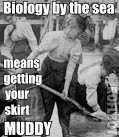Ed met and married Pamela Harrah, a Stanford graduate, in 1946. Their meeting was arranged by George W. Beadle, who had returned to Caltech from Stanford in 1946 to chair the biology division. That same year Ed had taken responsibility for supervising the extensive Caltech Drosophila Stock Center and was looking for a stock keeper. While still at Stanford, Beadle called Pam into his office and said, "Hey Pam, how tall are you?" to which Pam replied, "5'3"." Beadle then said, "Your new Boss is 5'4" tall, he's twenty-eight and maybe you will like him so much, you will fall in love and decide to stay there at Caltect." A few months after meeting, Ed and Pam were married; they remained so until Ed's death more than fifty-seven years later. It was Pam who, working as a technician in the laboratory in 1947, discovered the Polycomb gene, which Ed went on to report in his famous 1978 paper in Nature as the first "regulator of the regulators."
- p. 16, "Biographical Memoir," from Genes, Development, and Cancer by Edward B. Lewis and Howard D. Lipshitz
D'y'all wanna take bets on whether or not Pam gets credit in the paper? Any takers? I haven't looked yet, so I don't know. To be fair, at that time period she might not have gotten credit if she were male and not married to the PI; it only pisses me off because I've spent my *life* looking for women in science history, sometimes not even aware of it, and it just grates to find them hidden away in labs and footnotes of papers. I'm gonna find the paper now, and see if it soothes my nerves.
